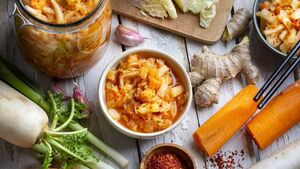Living Greener: The simple way to make your own kimchi

Homemade kimchee and glass jar
Many Irish are familiar with sauerkraut, but few Irish have experienced the magnificent flavour of kimchi, the dish to which Koreans are devoted.
It can be made easily at home with everyday ingredients, and I've been able to adapt it to whatever is ready in the garden at the moment.
Kimchi can be best described as a kind of Asian sauerkraut, a spicy pickled cabbage with ginger, garlic and other spices. It’s made with the same process that creates dill pickles – the technical term is lacto-fermentation – using a salty brine to preserve the food and give it a tangy bite. It can keep for as long as a few months, but can be ready in as little as a week.
To make kimchi, you will need:
To start, chop the cabbage into quarters, remove the cores, and slice into strips about five centimetres wide.
Mix the cabbage and the salt in a large bowl, and with your hands massage the salt into the cabbage for a few minutes.
Some people like to use gloves for handling the salt again, especially if you have sensitive skin. Then find a plate smaller than the top of the bowl, and place it on the cabbage to keep it in the salt.
You might want to put some jars on top – I used pickle jars evenly around the edges – to weigh it down. Leave it there for about two hours.
At the end of that time, the cabbage will be soft and sitting in a brine of its own juice and some salt. Take the cabbage out and drain in a colander, and clean the bowl to use again.
Then you make the kimchi paste, mixing the grated garlic, grated ginger, and chopped pepper together in a bowl.
Some recipes, I find, call for using flour to thicken the paste — I've tried it with and without, and haven't found it to make much difference.
Some people put in a bit of sugar at this point, some a bit of soy sauce, some a bit of seafood flavour like fish sauce or oyster sauce.
I didn’t like mine too sweet, and found fish sauce to be more to my taste. Chop up the radishes and scallions and add them to the mix.
Finally, mix the vegetables and paste with the cabbage, and massage them together as you did with the salt. There are hot peppers in there, so some people like to crack out the gloves again at this part.
Pack the cabbage into a clean glass jar – I used a pickle jar – pressing down until the brine rises to just barely cover everything.
Leave a bit of space at the top, and seal the lid – not too tightly, though, in case gas needs to escape. Check every day or two to loosen the lid just a crack, to make sure it’s not going to explode, and then when the gas has escaped, tighten it a little again. Let the mix stand for at least a week, and give it a try.
This recipe uses only minimal spice compared to the Korean original, but if it’s still too much, use less next time.
One good thing about this recipe is that, when people here grow cabbages, they tend to use the head only and throw the outer leaves away – they are tough and would not be good to chew. Kimchi, though, can be made from some outer leaves of cabbages, and so less goes to waste.





